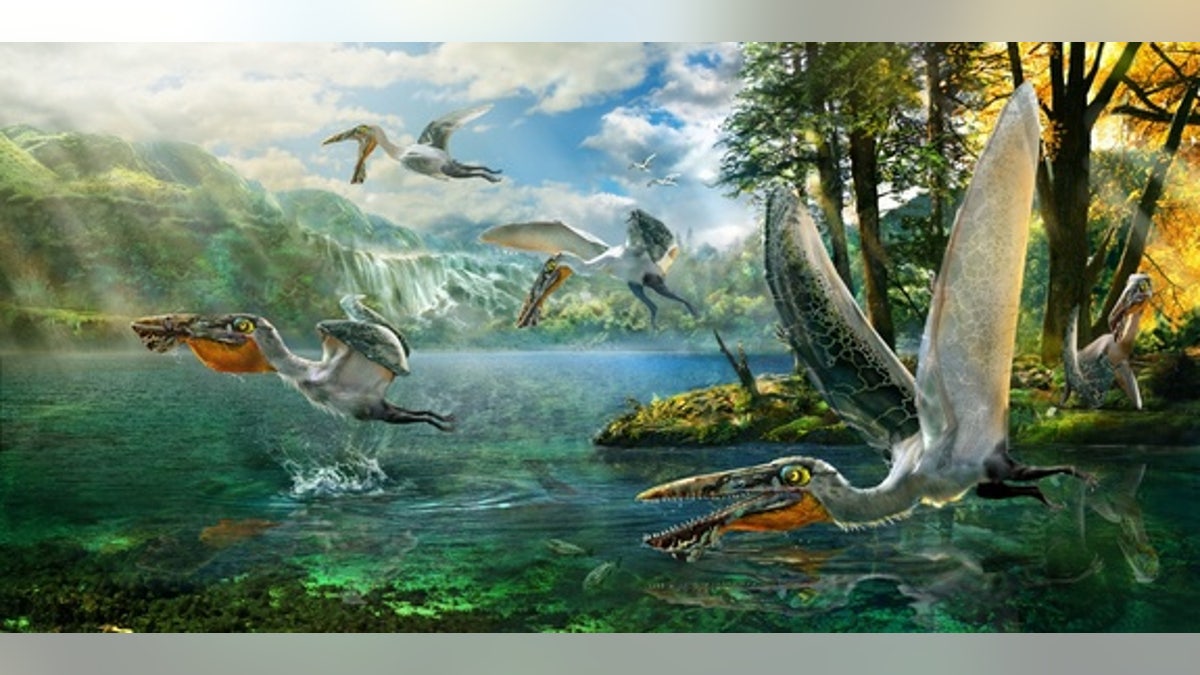
The remains of an extinct flying reptile (shown here in a reconstruction) that lived some 120 million years ago reveal the creature had a wingspan of 4.9 feet. (Chuang Zhao)
A sprawling ancient flying reptile looked so much like a dragon that could have flown alongside the aerial predators called "ikran" in the film "Avatar" that its discoverers named the newfound beast after these mountain banshees.
The pterosaur, now called Ikrandraco avatar ("draco" means "dragon" in Latin), may have stored food in a throat pouch like a pelican does, the researchers said.
Pterosaurs were the first vertebrates (animals with backbones) to flap wings to fly. Before pterosaurs went extinct in the catastrophic impact that also ended the Age of Dinosaurs, they were the biggest animals that ever flew, with wingspans measuring up to 39 feet. (Although pterosaurs lived alongside dinosaurs, these flying reptiles were not dinosaurs.)
Scientists investigated two partial skeletons of Ikrandraco dating back about 120 million years ago to the Early Cretaceous Period. They unearthed these fossils in arid hills in northeastern China's Liaoning province, which has become famous for the trove of feathered dinosaurs unearthed there over the last decade. Back when this reptile was alive, the area where it was found was a large freshwater lake with a warm climate that was home to many kinds of animals, such as fish, frogs, turtles, other pterosaurs, feathered dinosaurs, birds and mammals, as well as many plants, such as ferns, conifers, gingkos, cycads and some flowering plants. [Images of Pterosaurs: Flight in the Age of Dinosaurs]
The pterosaur was about 2.3 feet long and had a wingspan of about 4.9 feet. It had an elongated skull and a unique crest or bladelike bulge of bone on the tip of its lower jaw. The head of this newfound pterosaur is different from that of any other known pterosaurs, "but similar to [the head on] a flying creature, 'ikran,' in the movie 'Avatar,'" said lead study author Xiaolin Wang, a vertebrate paleontologist at the Institute of Vertebrate Paleontology and Paleoanthropology at the Chinese Academy of Sciences in Beijing.
The back of Ikrandraco's jaw crest had a little hooklike structure. The researchers suggested this notch may have served as an anchor for soft tissue, and they proposed that Ikrandraco had a throat pouch like the one a pelican uses to store food.
The researchers said that Ikrandraco might have sometimes foraged for food by hovering over water and scooping up prey near the surface. However, Ikrandraco is larger than modern skimming birds, so it may not have skimmed regularly, instead usually standing in shallow water to hunt, Wang said.
The researchers plan to conduct experiments to see whether Ikrandraco's jaw crest might have supported a throat pouch.
The scientists detailed their findings online Sept. 11 in the journal Scientific Reports.
Copyright 2014 LiveScience, a TechMediaNetwork company. All rights reserved. This material may not be published, broadcast, rewritten or redistributed.




















